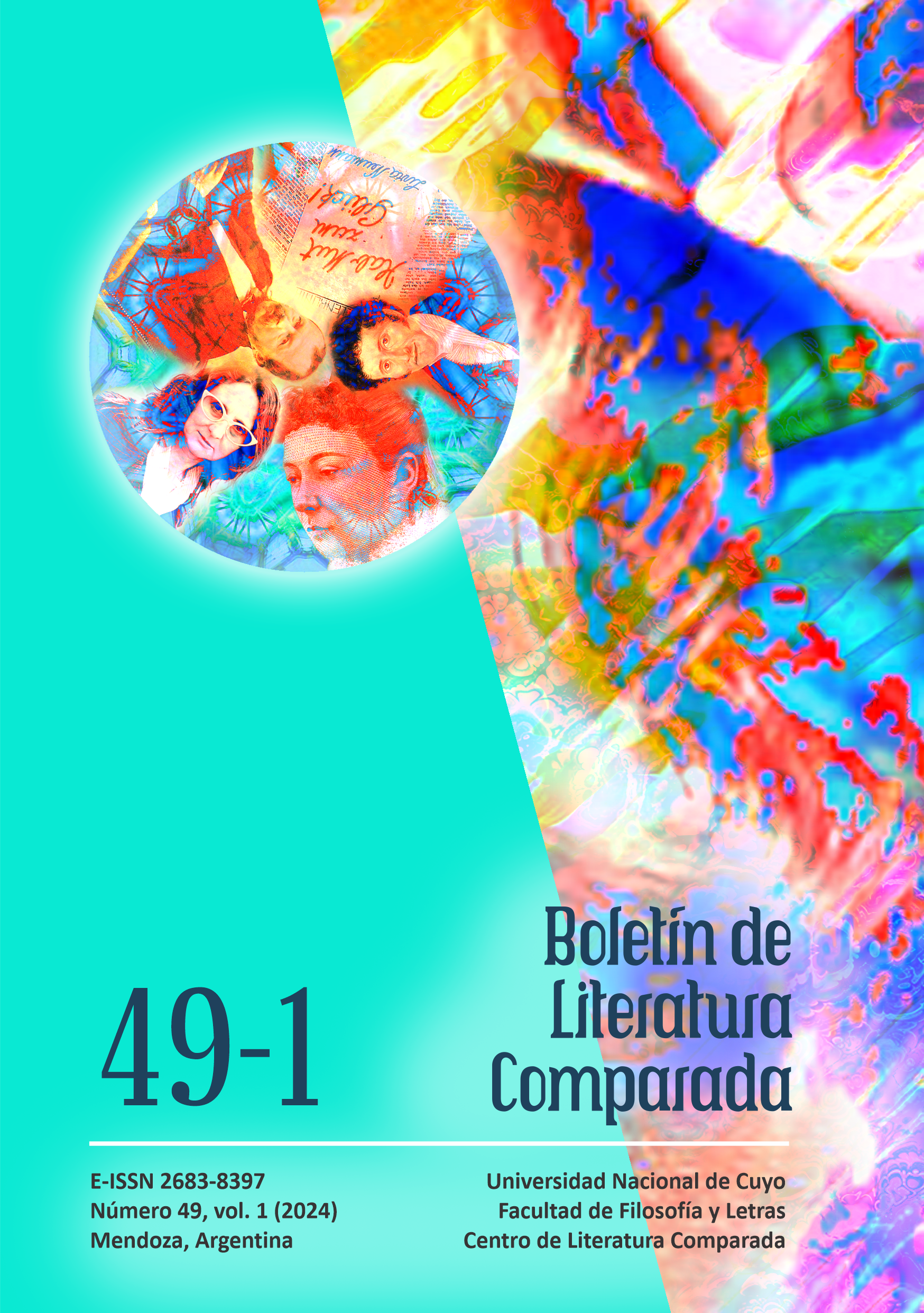"One of those half-mad Hoffmann heroes." Balzac, Hoffmann and the metaphysical foundation of The Human Comedy
DOI:
https://doi.org/10.48162/rev.54.034Keywords:
Honoré de Balzac, E. T. A. Hoffmann, fantastic Literature, Walter Scott, The Human ComedyAbstract
This article studies the centrality of E. T. A. Hoffmann's fantastic literature in Honoré de Balzac's poetics and, in particular, in the constitution of the system of The Human Comedy. It argues that Hoffmann's literature, translated and reformulated in the French literary market, is articulated as a metaphysical foundation of the system of The Human Comedy, in the category of "Philosophical Studies". To develop the proposition, the article works on the reception of Hoffmann's fantastic tales in France in the 1830s; Balzac's materialist reading of those texts; and on the basis of that reception and that reading, the constitution of a metaphysics that Balzac calls Theory of Will.
References
Balzac, Honoré de (1846c), La Peau de chagrin, Paris: Furne, Dubochet et Cie, Hetzel et Paulin. Recuperado 12/8/2023 de https://artflsrv03.uchicago.edu/philologic4/balzac/navigate/74/1/
Balzac, Honoré de (1846b), “L’Auberge rouge”, Paris: Furne, Dubochet et Cie, Hetzel et Paulin. Recuperado 30/8/2023 de https://artflsrv03.uchicago.edu/philologic4/balzac/navigate/69/1/
Balzac, Honoré de (1846), “L’Élixir de longue vie”, Paris: Furne, Dubochet et Cie, Hetzel et Paulin. Recuperado 29/8/23 https://artflsrv03.uchicago.edu/philologic4/balzac/navigate/70/1/
Balzac, Honoré de (1842), Louis Lambert, Paris : Furne, Dubochet et Cie., Hetzel et Paulin. Recuperado 31/8/2023 de https://artflsrv03.uchicago.edu/philologic4/balzac/navigate/27/1/
Balzac, Honoré de (1839), Une fille d’Ève, Paris: Hippolyte Souverain, recuperado el 5/6/2023 de https://gallica.bnf.fr/ark:/12148/bpt6k113380x/f3.item
Benjamin, Walter (2015), “El Berlín demoniaco”, en Radio Benjamin, Madrid: Akal, p.51-56.
Díaz, José-Luis (1993), “De l’artiste à l’écrivain où comment devenir l’auteur de La Comédie humaine?, en Claude Duchet, Isabelle Tournier, Le « Moment » de La Comédie humaine, Saint Denis : Presses Universitaires de Vincennes, p. 113-135. Recuperado el 10/9/2023, de https://books.openedition.org/puv/1628
Dickson, Polly Letitia (2017), The Stakes of Mimesis: Tracing Narrative Lines in the Works of E. T. A. Hoffmann and Honoré de Balzac, Cambridge: University of Cambridge, Wolfson College, mimeo.
Evans, Henri (1951), Louis Lambert et la philosophie de Balzac, Paris: José Corti.
Guise, Réne (1970), “Balzac, lecteur des ‘Élixirs du diable’”, L’année balzacienne, 1, p. 57-67.
Hagen, Kirsten von (2012), “Trangression und Transformation. E. T. A. Hoffmann, Balzac und die Oper als Schauraum”, en Bernd Kortländer, Hans T. Siepe (Hrsg.), Balzac und Deutschland-Deutschland und Balzac, Tübingen: Narr Francke Attempto.
Hoffmann, E. T. A. (1815), Die Elixiere des Teufels. Nachgelassene Papiere des Bruders Merdardus, eines Capuziners. Erstel Teil. Berlin: Duncker und Humblot. Recuperado 19/7/2023 de https://www.deutschestextarchiv.de/book/view/hoffmann_elixiere01_1815?p=7
Hoffmann, E. T. A. (1816), Die Elixiere des Teufels. Nachgelassene Papiere des Bruders Merdardus, eines Capuziners. Zweiter Teil, Berlin: Duncker und Humblot. Recuperado el 19/7/2023 de https://www.deutschestextarchiv.de/book/view/hoffmann_elixiere02_1816?p=7
Hoffmann, E. T. A. (1819), Fantasiestücke in Callot’s Manier – Blätter aus dem Tagebuche eines reisenden Enthusiasten. Erster Teil, Bamberg: Kunz. Recuperado el 29/7/2023 de https://de.wikisource.org/wiki/Beethovens_Instrumental-Musik
Hoffmann, E. T. A. (1817), Nachtstücke, Zweiter Teil, Berlin: Realschulbuchhandlung. Recuperado el 20/7/2023, de https://www.deutschestextarchiv.de/book/view/hoffmann_nachtstuecke02_1817?p=7
Hoffmann, E. T. A. (2016), Nocturnos, Madrid: Alianza. Trad. Celia Lupiani y Rafael Lupiani.
Klinkert, Thomas (2013), “Science, mysticisme et écriture chez Balzac («La Peau de chagrin », et « Louis Lambert ») », L’Année balzacienne, 14, p. 41-53.
Mayer, Paola (2019), The Aesthetics of Fear in German Romanticism, Montreal: McGill-Queen’s University Press.
Montilla Lerena, María Emilia (2019), “Destrucción y poder: lo fantástico en ‘L’Élixir de longue vie”, de Honoré de Balzac”, en Revista de Literaturas Modernas, 49, 2, p. 75-110.
Neumann, Gerhard (1998), “Anamorphose. E. T. A. Hoffmanns Poetik der Defiguration”, en Andres Kablitz y Gerhard Neumann, Mimesis und Simulation, Freiburg im Breisgau: Rombach.
Pankow, Egard (2004), "Literatur – Geschichte: Honoré de Balzac und E.T.A. Hoffmann und die Genese von Traditionen im ’Élixir de longue vie’", en Arcadia: International Journal for Literary Studies, 39, 1, p. 27-54.
Pascansky, Gabriel D. (2021), “Introducción. Sir Walter Scott como crítico literario”, en Walter Scott, Acerca de lo sobrenatural en composiciones de ficción, y particularmente en las obras de Ernest Theodore William Hoffmann, Buenos Aires: Editorial de la Facultad de Filosofía y Letras, p. 7-29.
Preston, Dargan E. (1934), “Scott and the French Romantics.” PMLA, vol. 49, no. 2, 1934. Recuperado el 21/12/2015 de http://www.jstor.org/stable/458180
Scott, Walter (1887), Essays on Chivalry, Romance and the Drama, London: Frederick Warne.
Scott, Walter (2021), Acerca de lo sobrenatural en composiciones de ficción, y particularmente en las obras de Ernest Theodore William Hoffmann, Buenos Aires: Editorial de la Facultad de Filosofía y Letras.
Teichmann, Elizabeht (1958), La Fortune de Hoffmann en France, Chicago, Illinois: mimeo.
Tournier, Isabelle (s/f), “La Peau de chagrin », recuperado el 22/08/2023 de https://www.maisondebalzac.paris.fr/vocabulaire/furne/notices/peau_de_chagrin.htm
Tranchida, Robert (s/f), “L’Élixir de longue vie”, recuperado el 22/08/2023 de https://www.maisondebalzac.paris.fr/vocabulaire/furne/notices/elixir_de_longue_vie.htm.
Vanoncini, André (2019) “De Goethe à Balzac: mythes et mitages du pacte”, Fabula / Les colloques, « Goethe, le mythe et la science. Regards croisés dans les littératures européennes », recuperado el 15/8/2020 de http://www.fabula.org/colloques/document6201.php.
Downloads
Published
How to Cite
Issue
Section
License

This work is licensed under a Creative Commons Attribution-NonCommercial-ShareAlike 4.0 International License.




